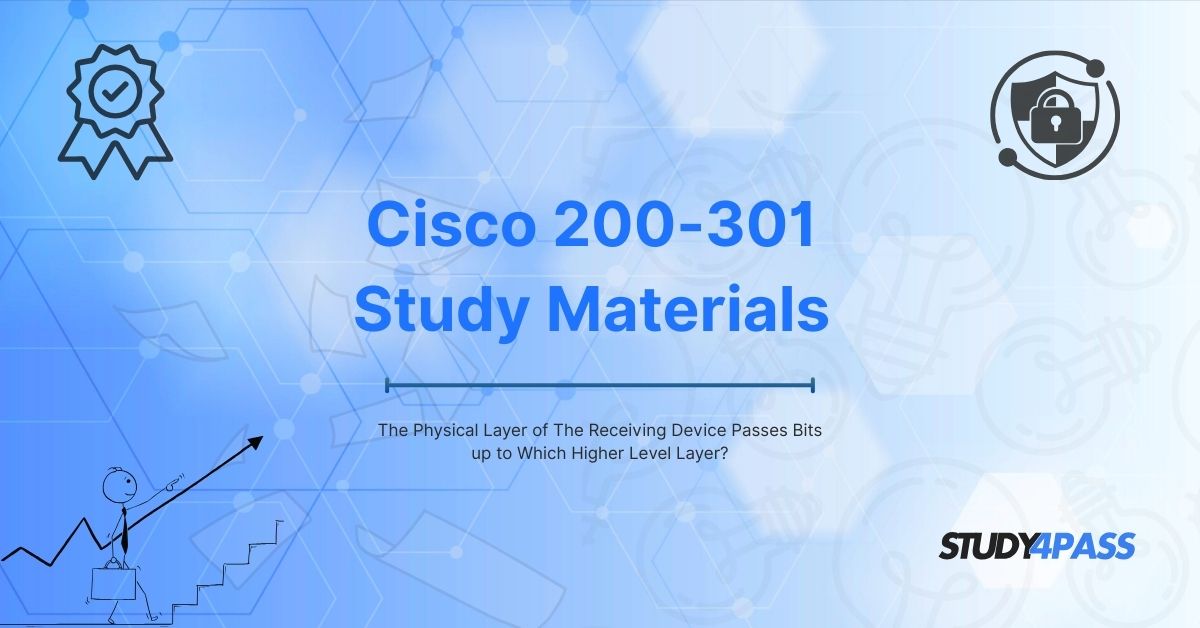Introduction to Physical Layer
The Physical Layer (Layer 1) of the OSI model is responsible for transmitting raw bitstreams over a physical medium. When a receiving device captures these bits, it must pass them up to a higher layer for further processing. But which layer comes next?
For those preparing for the Cisco 200-301 exam, understanding this fundamental networking concept is crucial. This article explores how the Physical Layer interacts with the Data Link Layer (Layer 2), key exam-related concepts, and the best study resources, including Study4Pass, to help you ace the exam.
Understanding the OSI Model
The Open Systems Interconnection (OSI) model is a seven-layer framework that standardizes network communication. Each layer has a specific function:
|
Layer |
Name |
Function |
|
7 |
Application |
Provides network services to user applications |
|
6 |
Presentation |
Handles data formatting, encryption, and compression |
|
5 |
Session |
Manages communication sessions between devices |
|
4 |
Transport |
Ensures reliable data transfer (TCP/UDP) |
|
3 |
Network |
Routes data packets (IP addressing) |
|
2 |
Data Link |
Manages frames and MAC addressing |
|
1 |
Physical |
Transmits raw bitstreams over a medium |
The Physical Layer (Layer 1) is the lowest layer and interacts directly with the Data Link Layer (Layer 2).
The Role of the Physical Layer
The Physical Layer is responsible for:
- Transmitting raw bits (0s and 1s) over wired (copper/fiber) or wireless media.
- Encoding and modulation (converting bits into signals).
- Defining physical connectors (RJ45, USB, SFP).
- Managing transmission rates (bandwidth, throughput).
When a receiving device gets these bits, the Physical Layer passes them up to the Data Link Layer (Layer 2), where they are organized into frames.
How the Physical Layer Passes Bits to the Higher Layer?
Step-by-Step Process:
- Transmission: The sender’s Physical Layer converts data into electrical/optical signals.
- Reception: The receiver’s Physical Layer detects signals and converts them back into bits.
- Handoff to Data Link Layer: The bits are passed to Layer 2, where:
- Framing: Bits are grouped into frames.
- Error Detection: Checks for corruption (CRC checks).
- MAC Addressing: Identifies source/destination devices.
Key Exam Concept:
- The Physical Layer sends bits to the Data Link Layer.
- The Data Link Layer then forwards frames to the Network Layer (Layer 3) based on MAC addresses.
Key Concepts for the Cisco 200-301 Exam
The Cisco 200-301 exam tests your understanding of networking fundamentals, including:
- OSI & TCP/IP models
- Ethernet framing & MAC addressing
- Network topologies & cabling
- Switching concepts (VLANs, STP)
Sample Exam Questions:
- Which layer receives raw bits from the Physical Layer?
- A) Network Layer
- B) Data Link Layer
- C) Transport Layer
- Answer: B) Data Link Layer
- A) Routing packets
- B) Transmitting raw bits
- C) Encrypting data
- Answer: B) Transmitting raw bits
Cisco 200-301 Exam Study Materials
To pass the CCNA 200-301 exam, you need reliable study resources, including:
- Official Cisco Cert Guides
- Practice Tests & Simulations
- Video Courses (e.g., CBT Nuggets, Udemy)
- Study4Pass – Premium Exam Prep Practice Test & Practice Questions
Why Choose Study4Pass for Cisco 200-301 Preparation?
Study4Pass is a top-rated platform for Cisco certification preparation, offering:
Real Exam Questions & Answers (updated regularly)
High-Quality Practice Tests (simulate real exam conditions)
Detailed Explanations (help reinforce key concepts)
Money-Back Guarantee (if you don’t pass)
How Study4Pass Helps You Succeed:
- Identifies Weak Areas: Pinpoints topics needing more focus.
- Boosts Confidence: Familiarizes you with exam patterns.
- Saves Time: Focuses on high-yield exam topics.
Frequently Asked Questions (FAQs)
Q1: Does the Physical Layer handle error correction?
No, error detection/correction is handled by the Data Link Layer (CRC checks) and Transport Layer (TCP retransmissions).
Q2: What devices operate at the Physical Layer?
- Hubs, Repeaters, Cables, NICs
Q3: How does Study4Pass compare to other exam prep sites?
Study4Pass provides up-to-date, verified questions with explanations, unlike many outdated or unreliable sources.
Conclusion
Understanding how the Physical Layer passes bits to the Data Link Layer is essential for networking professionals and Cisco 200-301 exam candidates. By mastering these concepts and using trusted resources like Study4Pass, you can boost your chances of passing the CCNA exam on the first attempt.
Ready to ace your exam? Visit Study4Pass today for the best CCNA 200-301 study materials!
Special Discount: Offer Valid For Limited Time “Cisco 200-301 Study Exam”
Sample Questions for Cisco 200-301 Exam Prep
Actual exam question from Cisco's 200-301 Guide.
1. After receiving raw bits from the transmission medium, the Physical Layer forwards them to:
a) Application Layer
b) Transport Layer
c) Data Link Layer
d) Network Layer
2. In the OSI model, which layer directly receives bits from the Physical Layer?
a) Session Layer
b) Transport Layer
c) Data Link Layer
d) Presentation Layer
3. The Data Link Layer is responsible for:
a) Converting bits into frames
b) Routing packets across networks
c) Establishing end-to-end connections
d) Encrypting data for security
4. Which layer comes immediately above the Physical Layer in the OSI model?
a) Network Layer
b) Transport Layer
c) Data Link Layer
d) Session Layer
5. When a device receives raw bits over a network, the next layer that processes them is the:
a) Application Layer
b) Data Link Layer
c) Transport Layer
d) Presentation Layer


